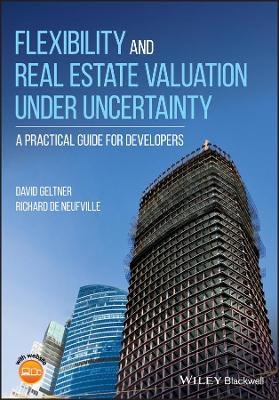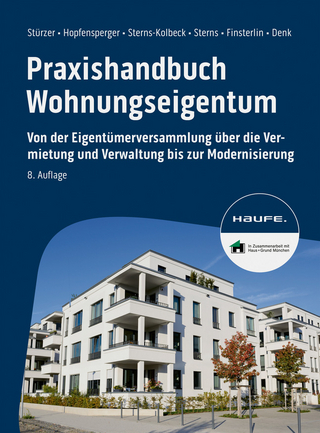
Flexibility and Real Estate Valuation under Uncertainty
Wiley-Blackwell (Verlag)
978-1-119-10649-4 (ISBN)
This book takes a practical "engineering" approach to the valuation of options and flexibility in real estate. It presents simple simulation models built in universal spreadsheet software such as Microsoft Excel®. These realistically reflect the varying and erratic sources of uncertainty and price dynamics that uniquely characterize real estate. The text covers new analytic procedures that are valuable for existing properties and enable a new, more profitable perspective on the planning, design, operation, and evaluation of large-scale, multi-phase development projects. The book thereby aims to significantly improve valuation and investment decision making.
Flexibility and Real Estate Valuation under Uncertainty: A Practical Guide for Developers is presented at 3 levels. First, it introduces and explains the concepts underlying the approach at a basic level accessible to non-technical and non-specialized readers. Its introductory and concluding chapters present the important “big picture” implications of the analysis for economics and valuation and for project design and investment decision making.
At a second level, the book presents a framework, a roadmap for the prospective analyst. It describes the practical tools in detail, taking care to go through the elements of the approach step-by-step for clarity and easy reference.
The third level includes more technical details and specific models. An Appendix discusses the technical details of real estate price dynamics. Associated web pages provide electronic spreadsheet templates for the models used as examples in the book.
Some features of the book include:
• Concepts and tools that are simple and accessible to a broad audience of practitioners;
• An approach relevant for all development projects;
• Complementarity with the author's Commercial Real Estate Analysis & Investments—the most-cited real estate investments textbook on the market.
Flexibility and Real Estate Valuation under Uncertainty: A Practical Guide for Developers is for everyone studying or concerned with the implementation of large-scale or multi-phase real estate development projects, as well as property investment and valuation more generally.
DAVID GELTNER, PhD is Professor of Real Estate Finance in the MIT Department of Urban Studies & Planning. He has taught for over 15 years in the MIT Center for Real Estate, playing a lead role in its Master of Science in Real Estate Development (MSRED) program. Geltner is a winner of the prestigious Pension Real Estate Association's Graaskamp Award for excellence and influence in the real estate investment industry. RICHARD DE NEUFVILLE, PhD is Professor of Engineering Systems at the Massachusetts Institute of Technology. He has received many international professional and teaching awards, including the Sizer Award for the Most Significant Contribution to MIT Education.
Foreword xiii
Author’s Preface xvii
Acknowledgement xxi
About the Companion Website xxiii
1 Discounted Cash Flow Valuation: The Basic Procedures and Concepts Underlying Spreadsheet Valuation Constitute the Springboard to our Approach of Analyzing Flexibility Under Uncertainty 1
1.1 Why the Focus on the Discounted Cash Flow Model? 2
1.2 Structure of a Discounted Cash Flow Spreadsheet 3
1.3 The Cash Flow Projection 5
1.4 Discount Rate 7
1.5 Market Value and Forward‐Looking (Ex‐Ante) Analysis 7
1.6 Backward‐Looking (Ex‐Post) Analysis 9
1.7 Conclusion 9
2 Economics of the Discounted Cash Flow Valuation Model: Understanding the Discount Rate is Critical 11
2.1 Choice of Discount Rate 11
2.2 Differences between Discount Rate, Opportunity Cost of Capital, and Internal Rate of Return 13
2.3 Net Present Value 14
2.4 Relationship between Discount Rate, Growth Rate, and Income Yield 15
2.5 Relationship between Discount Rate and Risk 18
2.6 Conclusion 19
3 Future Scenarios Matter: We Need to Recognize that Future Projections are Uncertain 21
3.1 The Standard Discounted Cash Flow Model Appears to be Deterministic 21
3.2 We Live in a World of Uncertainty 23
3.3 Discounted Cash Flow Pro Forma Cash Flows are Expectations 24
3.4 Flexibility and Options 26
3.5 Conclusion 26
4 Scenario Analysis: Future Scenarios can Significantly and Surprisingly Affect the Present Value 27
4.1 Discounted Cash Flow Scenario Analysis 27
4.2 Scenarios Affect Value 29
4.3 Flexibility Has Value 30
4.4 Conclusion 32
5 Future Outcomes Cover a Range of Possibilities: We Can Describe Uncertainties in Real Estate Using Probability Distributions of Possible Future Outcomes 33
5.1 Distribution of Future Outcomes 34
5.2 Quantifying Input Distributions 34
5.3 Distributions of Outcomes Differ from Distributions of Inputs 38
5.4 Flaw of Averages 39
5.5 Conclusion 40
6 Simulation of Outcomes: Simulation is a Practical, Efficient Way to Explore Uncertainty and to choose between Alternative Strategies for Managing it 41
6.1 Generating Scenarios 41
6.2 Real Estate Simulation in a Nutshell 42
6.3 Simulation is an Efficient Process 43
6.4 Number of Trials 44
6.5 Conclusion 45
7 Modeling Price Dynamics: Using Pricing Factors to Model the Dynamics of Real Estate Markets 47
7.1 Pricing Factors 47
7.2 Random Walks 49
7.3 Real Estate Pricing Factor Dynamics 51
7.4 Conclusion 52
8 Interpreting Simulation Results: Target Curves and Scatterplots can be used to Graph the Distribution of the Sample Output 53
8.1 Target Curves 53
8.2 Comparing Target Curves 57
8.3 Value at Risk 57
8.4 Scatterplots 57
8.5 Conclusion 59
9 Resale Timing Decision: Analysis: Let’s See what happens when we apply the Tools of Flexibility Analysis to a Classical Investment Decision: when to sell the Property 61
9.1 The Resale Timing Problem 62
9.2 Extending the Time Horizon of the Discounted Cash Flow Model 62
9.3 IF Statements 63
9.4 Trigger Value for Stop‐Gain Rule 64
9.5 Value of Example Stop‐Gain Rule 64
9.6 Conclusion 68
10 Resale Timing Decision: Discussion: Let’s think about Additional Insights we can get from Simulation 69
10.1 Sensitivity Analysis 69
10.2 When to Use the Stop‐Gain Rule 70
10.3 Implications of Flexibility for Property Valuation 71
10.4 Conclusion 72
11 Development Project Valuation: This Chapter Looks at Valuation of Development Projects From an Investment Perspective, Considering Uncertainty, Flexibility, and Time‐to‐Build 73
11.1 Time‐to‐Build Difference between Development Projects and Existing Assets 74
11.2 Lower Opportunity Cost of Capital for Construction Costs 75
11.3 Illustrative Example 77
11.4 Residual Value of Development Land 78
11.5 Investment Risk in Development Project 79
11.6 Conclusion 80
12 Basic Flexibility in Development Projects: The Most Basic Flexibility in Real Estate Development is the Option to Choose whether and when to Build 83
12.1 Review of Call (and Put) Options 84
12.2 Land as a Call Option on Development 85
12.3 Drivers of Option Value 85
12.4 A Practical Example of a Call (and Put) Option 86
12.5 Flexibility and Scenario Analysis for Development Projects 88
12.6 Conclusion 90
13 Option Dichotomies: We Introduce a Typology of Flexibility in Development Projects 91
13.1 Three Dichotomies for Thinking Generally about Development Options 91
13.2 Defensive versus Offensive Options 92
13.3 Options “On” and “In” Projects 93
13.4 Timing Options versus Product Options 94
13.5 Conclusion 94
14 Product Options in Development: We Discuss Three types of Product Options 95
14.1 Concept of Base Plan 95
14.2 Product Expansion Flexibility 96
14.3 Product Mix Flexibility 98
14.4 Conclusion 98
15 Timing Options in Development: Now we Turn to the Types of Timing Options 99
15.1 Project Start‐Timing Flexibility (The Delay Option) 99
15.2 Project Production Timing Flexibility 100
15.3 Modular Production Timing Flexibility 102
15.4 Phasing Timing Flexibility 103
15.5 Types of Phasing 103
15.6 Recognizing Defensive and Offensive Options in Simulation Results 104
15.7 Conclusion 107
16 Garden City: An Example Multi‐Asset Development Project: We Present the Traditional DCF Valuation Spreadsheet Model for the Example Development Project We use in the Rest of Book 109
16.1 Overview of Multi‐Asset Development Project 110
16.2 Structure of a Realistic Multi‐Asset Spreadsheet Pro Forma 111
16.3 Cash Flows for the Example Pro Forma 113
16.4 Temporal Profile for Base Case 115
16.5 Expected Economics of the Garden City Project 116
16.6 Conclusion 118
17 Effect of Uncertainty without Flexibility in Development Project Evaluation: We Re‐analyze the Garden City Project by Reflecting Uncertainty Without Flexibility 119
17.1 Modeling Uncertainty for the Multi‐Asset Development Project 120
17.2 Generating Random Future Scenarios 122
17.3 Outcomes Reflecting Uncertainty for the Multi‐Asset Development 123
17.4 Effect of Different Probability Inputs Assumptions 127
17.5 Conclusion 129
18 Project Start‐Delay Flexibility: We Model the Value of the Most Basic and Widely Available Development Project Option 131
18.1 Project Start‐Delay Option 132
18.2 Option Exercise Decision Rule 132
18.3 Defining “Profit” in the Decision Model 134
18.4 Value of Start‐Delay Flexibility in the Garden City Project 134
18.5 Conclusion 138
19 Decision Rules and Value Implications: We Further Explore the Option to Delay the Project Start 139
19.1 Simple Myopic Delay Rule 140
19.2 Trigger Values 140
19.3 Value Implications of the Decision Rules 141
19.4 Effect of Trigger Values (Start or Delay Bias) 143
19.5 Review the Meaning of Flexibility Value 145
19.6 Conclusion 146
20 Modular Production Timing Flexibility: We Explore the Timing Option to Pause and Restart the Project Any Time After its Commencement 147
20.1 Modular Production Timing Flexibility 148
20.2 Modeling the Modular Production Option 148
20.3 Value of Modular Production Timing Flexibility 150
20.4 Effect of Trigger Values (Bias toward Pause or Continue) 152
20.5 Effect of Combining Start‐Delay and Modular Production Delay Flexibility 154
20.6 Conclusion 157
21 Product Mix Flexibility: This Chapter Presents the Option to Change Product Mix, and Examines the Effect of Volatility on Option Value 159
21.1 Product Mix Flexibility 160
21.2 Modeling the Product Mix Option 160
21.3 Value of Product Mix Flexibility 161
21.4 Effect of Combining Product Mix Flexibility and Timing Options 165
21.5 Effect of Correlation in the Product Markets on the Value of Product Mix Flexibility 167
21.6 Effect of Volatility on the Value of Flexibility 169
21.7 Conclusion 172
22 Project Phasing Flexibility: We Show How to Model and Evaluate the Delay Flexibility Inherent in Project Phasing 173
22.1 Modeling the Sequential Phase Delay Option 173
22.2 Modifying the Garden City Project Plan 174
22.3 Project Economics 177
22.4 The Delay Decision Model 178
22.5 Exploring the Value of Project Phasing Flexibility 179
22.6 Conclusion 182
23 Optimal Phasing: We Now look at Adding Phases, Delineating Phases, and Distinguishing them from Expansion Options 183
23.1 Effect of Increasing the Number of Phases 184
23.2 Principles for Optimal Phasing 186
23.3 What is the Difference between a Phase and an Expansion Option? 190
23.4 Conclusion 191
24 Overall Summary: We summarize the Main Takeaway Points from this Book 193
Appendix 197
Glossary 213
Acronyms and Symbols 219
Index 221
| Erscheinungsdatum | 11.07.2018 |
|---|---|
| Verlagsort | Hoboken |
| Sprache | englisch |
| Maße | 170 x 244 mm |
| Gewicht | 490 g |
| Themenwelt | Wirtschaft ► Betriebswirtschaft / Management ► Rechnungswesen / Bilanzen |
| Betriebswirtschaft / Management ► Spezielle Betriebswirtschaftslehre ► Immobilienwirtschaft | |
| ISBN-10 | 1-119-10649-4 / 1119106494 |
| ISBN-13 | 978-1-119-10649-4 / 9781119106494 |
| Zustand | Neuware |
| Haben Sie eine Frage zum Produkt? |
aus dem Bereich


